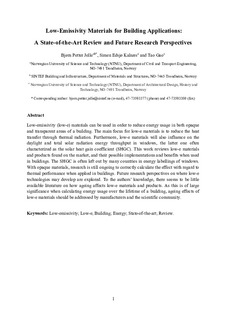| dc.contributor.author | Jelle, Bjørn Petter | |
| dc.contributor.author | Kalnæs, Simen Edsjø | |
| dc.contributor.author | Gao, Tao | |
| dc.date.accessioned | 2017-10-05T12:21:14Z | |
| dc.date.available | 2017-10-05T12:21:14Z | |
| dc.date.created | 2015-03-12T12:59:21Z | |
| dc.date.issued | 2015 | |
| dc.identifier.citation | Energy and Buildings. 2015, 96 329-356. | nb_NO |
| dc.identifier.issn | 0378-7788 | |
| dc.identifier.uri | http://hdl.handle.net/11250/2458720 | |
| dc.description.abstract | Low-emissivity (low-e) materials can be used in order to reduce energy usage in both opaque and transparent areas of a building. The main focus for low-e materials is to reduce the heat transfer through thermal radiation. Furthermore, low-e materials will also influence on the daylight and total solar radiation energy throughput in windows, the latter one often characterized as the solar heat gain coefficient (SHGC). This work reviews low-e materials and products found on the market, and their possible implementations and benefits when used in buildings. The SHGC is often left out by many countries in energy labellings of windows. With opaque low-e materials, research is still ongoing to correctly calculate the effect with regard to thermal performance when applied in buildings. Future research perspectives on where low-e technologies may develop are explored. To the authors’ knowledge, there seems to be little available literature on how ageing affects low-e materials and products. As this is of large significance when calculating energy usage over the lifetime of a building, ageing effects of low-e materials should be addressed by manufacturers and the scientific community. | nb_NO |
| dc.language.iso | eng | nb_NO |
| dc.publisher | Elsevier | nb_NO |
| dc.rights | Attribution-NonCommercial-NoDerivatives 4.0 Internasjonal | * |
| dc.rights.uri | http://creativecommons.org/licenses/by-nc-nd/4.0/deed.no | * |
| dc.title | Low-Emissivity Materials for Building Applications: A State-of-the-Art Review and Future Research Perspectives | nb_NO |
| dc.type | Journal article | nb_NO |
| dc.type | Peer reviewed | nb_NO |
| dc.description.version | acceptedVersion | nb_NO |
| dc.source.pagenumber | 329-356 | nb_NO |
| dc.source.volume | 96 | nb_NO |
| dc.source.journal | Energy and Buildings | nb_NO |
| dc.identifier.doi | 10.1016/j.enbuild.2015.03.024 | |
| dc.identifier.cristin | 1231617 | |
| dc.relation.project | Norges forskningsråd: 207551 | nb_NO |
| dc.relation.project | Norges forskningsråd: 193830 | nb_NO |
| dc.description.localcode | © 2015. This is the authors’ accepted and refereed manuscript to the article. This manuscript version is made available under the CC-BY-NC-ND 4.0 license http://creativecommons.org/licenses/by-nc-nd/4.0/ | nb_NO |
| cristin.unitcode | 194,64,35,0 | |
| cristin.unitcode | 194,61,25,0 | |
| cristin.unitname | Institutt for bygg, anlegg og transport | |
| cristin.unitname | Institutt for byggekunst, historie og teknologi | |
| cristin.ispublished | true | |
| cristin.fulltext | original | |
| cristin.fulltext | postprint | |
| cristin.qualitycode | 2 | |

